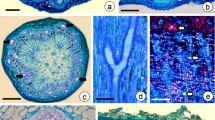Abstract
Early development of the secretory cavity of chemically fixed peltate glands in Humulus lupulus L. showed secretions with different densities, light, gray and dark, in the cytoplasm of disc cells and in the periplasmic space adjacent to the developing secretory cavity. Secretions were detected in the disc cell wall and subsequently in the developing secretory cavity under the subcuticular wall of the sheath. Light and gray secretions in the cavity possessed a membrane-like surface feature. Secretions were in contact with the irregular inner surface of the cuticle. Secretions contributed to the thickening of the cuticle, whereas the membrane-like surface feature contributed to a network of Cannabis striae distributed throughout the cuticle. This study supports an early development and organization of the secretory cavity in H. lupulus, parallel to those in Cannabis, and may represent common features for lipophilic glands in angiosperms.
Similar content being viewed by others
Author information
Authors and Affiliations
Corresponding author
About this article
Cite this article
Kim, ES., Mahlberg, P.G. Early Development of the Secretory Cavity of Peltate Glands in Humulus lupulus L. (Cannabaceae). Mol Cells 10, 487–492 (2000). https://doi.org/10.1007/s10059-000-0487-5
Received:
Issue Date:
DOI: https://doi.org/10.1007/s10059-000-0487-5




